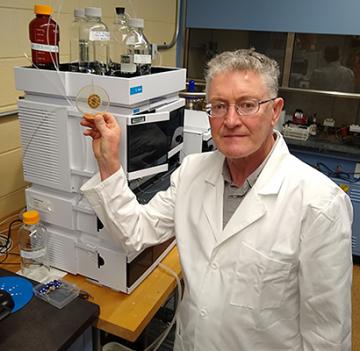From Toxin To Tonic

Human history is, in many ways, the story of a competition pitting us against the microbes that cause disease. Now, one enterprising ARS researcher is using microbes’ own defenses to help tip the contest in our favor.
Neil Price, a research chemist at the National Center for Agricultural Utilization Research (NCAUR) in Peoria, IL, has devoted his career to studying a chemical compound known as tunicamycin. Produced by soil microbes, it is normally very effective at killing pathogens – but unfortunately, tends to also be toxic to animals. It might knock out a nasty strain of tuberculosis, but take the animal or person infected with it as well. Price, however, has found an approach that appears to render the compound safe for animals, while preserving its ability to slay dangerous bacteria.
With his colleague Mike Jackson, a research chemist at NCAUR, Price chemically modified tunicamycin to create a related compound, called TunR2. The modified compound showed promising initial lab results, suggesting that the toxic trait had been eliminated. Armed with that data, Price has continued to test TunR2 to ensure it is safe for animals; if it is, its ability to kill bacteria might be deployed against a number of different diseases they cause. Recently, Price partnered with John Bannantine and Alejandra Colombatti Olivieri, of the ARS National Animal Disease Center in Ames, IA, to test the compound in Holstein cattle that were infected with Johne’s Disease, a debilitating bacterial ailment that affects more than two-thirds of America’s dairy herds. Their hope was that TunR2 might cure the disease. While it did not accomplish that goal in the initial tests, the infected cattle were not harmed when treated with it – a fact that bodes well for future research.

ARS research chemist Neil Price in the lab with a bacterial culture. (Image courtesy of Neil Price)
That future research includes pairing TunR2 with another, more familiar tool in the fight against infection: the penicillin class of drugs, one of humanity’s most important weapons against bacterial disease. First developed in the mid-twentieth century, these potent antibiotic drugs have transformed the practice of medicine, saving countless lives. However, as the drugs have been used widely in humans and animals alike, the bacteria they combat have gradually become resistant to them, rendering the drugs less effective. Developing new drugs can be difficult. With TunR2, however, there is an opportunity to re-invigorate the classic drugs – a huge potential win, given that they are already well-understood, approved, and in production.
Essentially, Price explained, the penicillin drugs work by impairing bacterial cells’ formation of new cell walls during cell division, a part of their growth process. Instead of multiplying, the weakened bacterial cells burst open and die. However, penicillin’s ability to interfere with this process decreased as the bacteria became resistant to it. TunR2, though, compromises the formation of the bacterial cell wall even earlier in the process, disrupting it in such a way that the bacteria are rendered vulnerable to penicillin once again. In order for this to happen, it is important that both the TunR2 and penicillin be present around the same time – not a simple feat. Figuring out how to ensure that happens is part of Price’s ongoing research agenda.
Fundamentally, Price said, “TunR2 is a new way to fight bacterial disease, either by itself as a novel antibiotic drug or in potent combination with an old friend, penicillin.” Now, the challenge is to test additional possible applications of TunR2 in other animals, in the hope that it will not only be tolerated, but will also work with penicillin in the way that earlier results suggested. If it does, it may be a critical lifeline for modern medicine, keeping some of its most important tools – and many living creatures – around much longer. — Kathryn Markham, ARS Office of Communications

